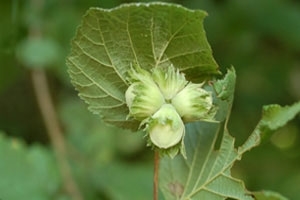Hazel (Corylus avellana)
 During January, one of the first signs of spring is the appearance of hazel catkins or as many country folk call them, lamb’s tails. These are, in fact, male flowers of the hazel and from the middle of February, they will start to release pollen into the air. If you take a closer look at the hazel branch you will see the little female flowers – little clusters of red threads just like tiny anemones and it is these that will “catch” the passing airborne pollen. Once fertilised, these female flowers will slowly change so that come September they will have turned into nuts.
During January, one of the first signs of spring is the appearance of hazel catkins or as many country folk call them, lamb’s tails. These are, in fact, male flowers of the hazel and from the middle of February, they will start to release pollen into the air. If you take a closer look at the hazel branch you will see the little female flowers – little clusters of red threads just like tiny anemones and it is these that will “catch” the passing airborne pollen. Once fertilised, these female flowers will slowly change so that come September they will have turned into nuts.
The hazel is sometimes known as the tree of knowledge and its wood is considered the best material for making rods of power, divining sticks, and because of its magical powers, even wands. A nut carried in the pocket was also considered to bring good luck, prosperity and even help ward off rheumatism. A double nut, (two on the same stem) often known as St. John’s nut, was particularly sought after as a symbol of fertility. Hazel wood is wonderfully tough and pliable and is therefore used for a wide range of products including hoops for wooden barrels, fencing hurdles, walking sticks, spars for thatching, faggots for repairing river banks and was also one of the main woods used as the wattle in wattle and daub for house and barn building.
Because of the versatility of hazel, it was coppiced regularly in our local woods and was an important source of income, indeed for many it was their full time job. One man would take a year to work three acres of hazel coppice and usually a seven-year rotation was traditionally followed, meaning that 20 acres or so of coppice could keep a man fully employed. The woods where these men worked often had the smell of burning wood, as most of the off-cuts would be used to make charcoal – another product where hazel reigns supreme.
Peter Thompson
Advisory

Download Peter Thompson's essential 26-page book, featuring beautiful photography and detailed profiles of Britain's wildlife
Download FREE >